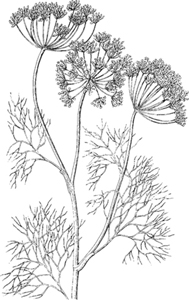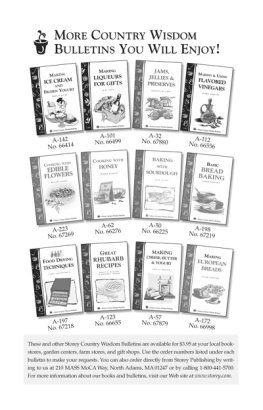Growing & Using Dill
by Glenn Andrews
CONTENTS
Introduction
Dill is a lovely herb. Many (and I feel this way myself) think it has the most downright refreshing taste of any herb. If you doubt this, take any ho-hum recipe, add a little dill, and watch (taste!) what happens. It can seem like magic. (The addition of just a bit of lemon or lime juice or vinegar helps this magic, as in the lamb stew on page 14 or the lima beans on page 21.)
Dills use in the kitchen has been documented through the centuries and in countries around the world. Further, it has been used medicinally (particularly in the form of dill tea) as a purported cure for hiccups, insomnia, and even flatulence. There are those, even today, who consider dill a great booster of the immune system and a natural antibiotic that can fight bacterial infections as well as colds and the flu. And quite a while ago, it was considered to be a guard against evil witches.

Its an all-purpose herb, obviously, but I do think its best use is to add a piquant and delightful flavor to many sorts of food.
Im a firm believer that you can substitute almost any herb for almost any other herb in just about any recipe. Thus you can substitute oregano for marjoram, or even thyme for either of them.
This, however, does not apply to dill. Its taste is simply too distinctive. When you want dill, you want dill! The only other herb this applies to is tarragon, which also has its own particular taste, unlike any other. On second thought, Id have to add cilantro to the do not substitute list. Its flavor is certainly unique.
Technically, dills name is Anethum graveolens. Two parts are used the soft, leafy, fernlike leaves or fronds and the seeds. Somehow (and its hard to imagine how this came to be), the leafy part of the plant has come to be called dillweed. If I had to guess, Id say that somewhere along the line someone decided that there should be a verbal distinction between the fronds and the seeds, and so we have dillweed and dill seeds.
Luckily, dill is very easy to grow. Ill guide you through the planting of seeds, then take you on a tour of the growing season and give you some ideas for preserving your harvest.
And then Ill give you a choice selection of dill-sparked recipes to try. I urge you to try all of them theyre extraordinary.
One word of warning about buying commercially dried dillweed. There are some cut-rate dills out there that have virtually no taste at all. If youre not going to be able to grow your own, be cautious. You can pretty much spot the inferior products by their color: They have a grayish look to them, rather than a vibrant green. To be fairly safe, buy an expensive brand. But better yet, buy in bulk (even in small amounts, if thats what you want) at health food stores or food co-ops.
Growing Your Own Dill
If youve never grown annual herbs before, dill might be a good one to start with. It will thrive, in spite of almost everything you might do to it!
I strongly suggest that you grow your dill from seeds, sown right where you want the plants to be, rather than either buying plants and transplanting them or starting the seeds indoors early in the spring, then moving them outdoors. Despite the fact that dill really is a cinch to grow, it does have fragile stems that could easily be crunched in the course of being transplanted. I have even seen it listed as being impossible to transplant. I doubt this, but it certainly wouldnt be an easy task.
At any rate, I cant see any point in trying to transplant dill. The seeds can go in the ground in early spring, and they germinate very well and quite quickly.
Obtaining Seeds
The first thing you have to do is decide whether you want your dill plants to give you mostly greens to use as herbs or seeds to use primarily in pickles. Theres a third choice, too you can use the green part for a while, then let the plants go to seed.
If that third choice is what you want, youll find packets of seeds for planting in nearly every supermarket and most hardware and garden stores.
But if you choose to plant primarily for greenery or primarily for seeds, see page 32 for mail-order sources of specialized seeds.
Where, When, and How to Plant
Dill, like other herbs and vegetables, is a true sun lover. The ideal spot for it is in full sun, but its an agreeable plant and will also do well with a half days sun.
Because it grows to be up to 3 feet (0.9 m) tall, your dill is best positioned in the back of your herb garden, so it wont overshadow (literally) your other plants.
For that matter, dill will thrive in a spot where its mixed in with flowers and/or vegetables. Its frondlike leaves can create the same effect in the garden that ferns do in a flower shop bouquet. Just, as mentioned above, make sure it wont rob anything else of sun or be robbed of sun itself by other vigorously growing plants.
As to when to put the seed into the ground, dill is a plant that loves coolness. If you live in a region where there are heavy frosts, plant the seeds in early spring. The backs of seed packets will tell you to wait until the date of the average last frost, but you can cheat a bit on that! Since germination takes from 10 to 21 days, you can at least plant that far ahead of the average last hard frost.
If, however, you live where there are no hard frosts, you can sow the seeds from midfall to early spring.
Either way, its a good idea to lay in a good supply of seeds and sow every 10 days or so. In the case of the cold-region garden, youll find that your best dill crops will come from seeds sown in spring or early fall.
Ive read many times that herbs actually prefer to grow in poor soil. I used to believe this and acted accordingly, but now Im convinced that any herb will do better if it grows in good, fertile soil. Treat the soil where youll be growing dill as you would any other where you want a good crop: Prepare it deeply; add compost; work in some well-rotted manure; rake it well.
Plant the seeds to inch (3 to 6 mm) deep, and press down gently. Keep well watered until the little plants poke their heads up through the soil.
Again, I have a quarrel with conventional wisdom in regard to the spacing of your plants. Youll be told, over and over, to thin your dill plants until they are 2 feet (60 cm) apart. I, on the other hand, suggest that you leave them in little clusters in which they are no more than 1 foot (30 cm) from each other. Even 6-inch (15-cm) spacing will work out well. But either way, you are just about guaranteed a great crop.
Can you plant dill seeds in containers? Of course. But do remember that youre going to have very tall plants, so plan accordingly, using rather deep containers.
Harvesting and Preserving Your Dill
There are, of course, two approaches to harvesting your lovely crop of dill one for the dillweed, the other for the dill seeds. Naturally, they have to be done at different times.
During the growing season, its great to just go out in your garden and pick the amount of dill you need for your next meal. Thats the ideal way.
But if you have a big crop and wish to preserve it, try drying it in a microwave oven. Simply spread the dill in a single layer on paper towels and microwave on high for 3 minutes. The result will delight you youll have bright green, perfectly dry, totally delicious dill. After microwaving, remove and discard the hard stems and crumble the leaves with your fingers. Store in an airtight container away from bright light to best preserve the flavor.



